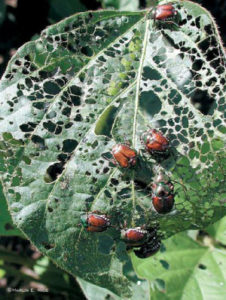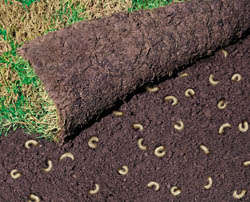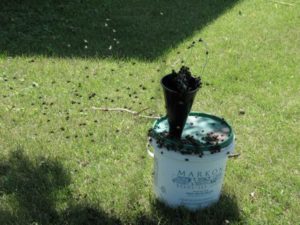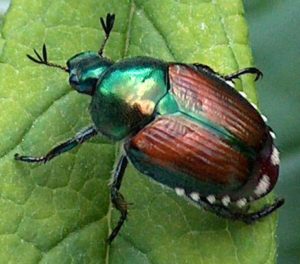More on Japanese Beetles
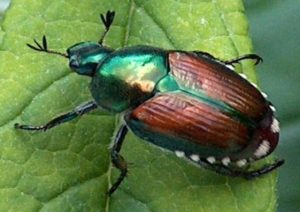 It is early to discuss Japanese Beetles, the grubs are still lurking amid the grass roots in your lawn. Here in South Denver we will be heading into our fourth season of the attacks. They eat roses, grape leaves, linden, peach leaves, buckthorn, Virginia creeper, and raspberry bushes, to list our victims. The beetles emerge with the hot weather and stick around until sometime in August. Then the battle begins.
It is early to discuss Japanese Beetles, the grubs are still lurking amid the grass roots in your lawn. Here in South Denver we will be heading into our fourth season of the attacks. They eat roses, grape leaves, linden, peach leaves, buckthorn, Virginia creeper, and raspberry bushes, to list our victims. The beetles emerge with the hot weather and stick around until sometime in August. Then the battle begins.
There are limited methods of control, but our grape arbor is doomed. I conduct a summer long counterattack, using neem oil, soap spray, and physical removal. I grab the little bastards and drown them in soapy water. I am supposed to be practicing the Buddhist principle of not harming living beings, but watching the evil bugs struggling in the water is satisfying.
Last evening we went to a meeting organized by the Colorado State University Extension service on the scourge. It was held in one of the old boathouses in Washington Park, now occupied by Outdoor Colorado. There is a nice conference room which easily accommodates a couple of dozen people. About 100 people showed up. There were people sitting on the floor and standing along the walls. Overflow went out the door. It got hot and stuffy.
When the beetles first showed up, we went to CSU Extension, not far away. Back then we mostly got unknowing shrugs. Last season, the presenter said almost every call was about beetles. They had to do some fast learning. Another impetus for them was watching their flower garden be almost wiped out.
Our own research covered most of the information given in the meeting, there were a few new things and more information about what does not work. For grapes and most of the vulnerable annuals, resistance is futile. Grapes and Virginia Creepers are over. Our linden tree gets lots of destroyed leaves, but it is robust enough to take the damage in stride.
With the other stuff, it’s a fight. Going around with a bowl and stick knocking them into the water is tedious, but works. The best suggestion we got is to use a cordless dust buster. Expanding on that, I will try the leaf gathering function on the leaf blower. The collection bag might get nasty, but they say crushing the beetles doesn’t attract others.
The most important takeaway from the meeting is how many other people are just as angry and obsessed as I am. I guess Japanese Beetles have become my teachers. I get the chance to work on obsession, resentment, and hate.


